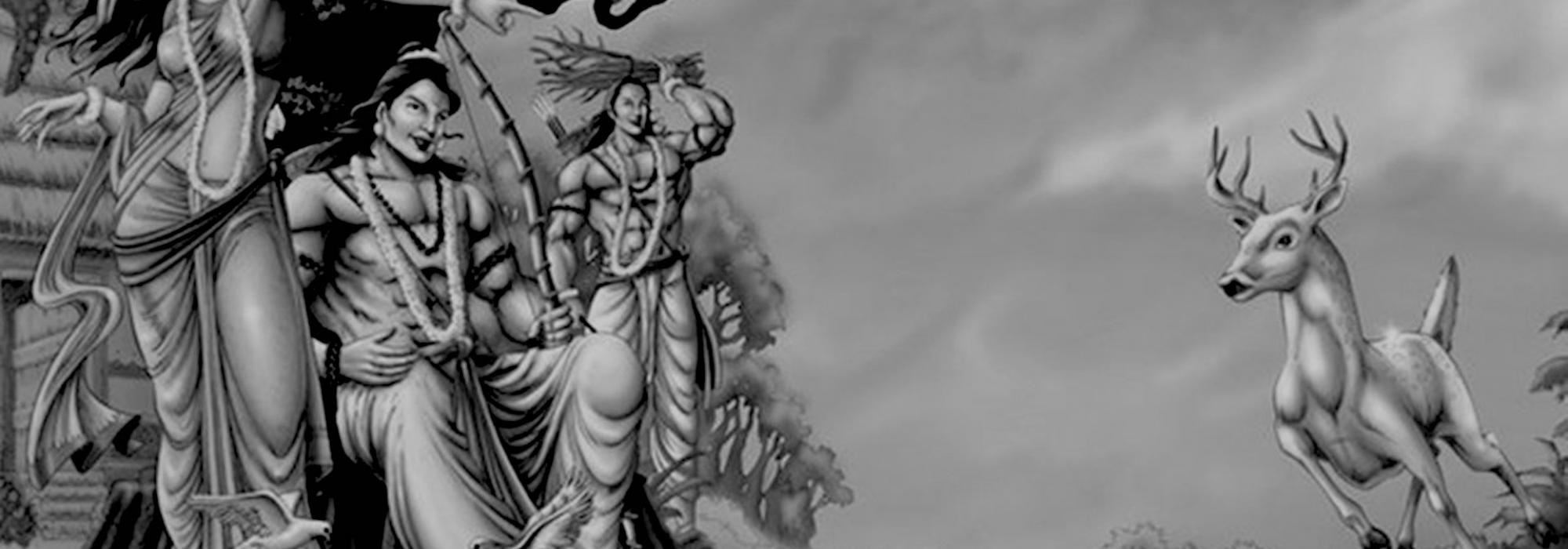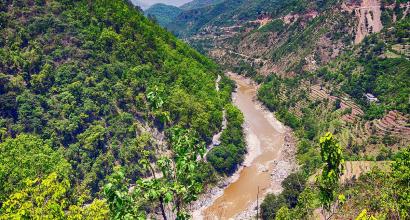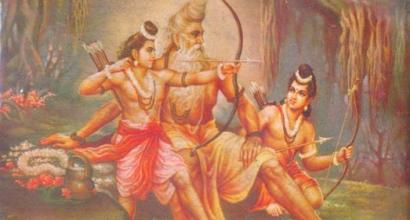According to Agastya’s instructions, when Sri Rama goes and resides in Panchavati, the major events in the story occur there. Shurpanakha sees Sri Rama, becomes infatuated with him, approaches him and pleads with him, “become my husband.” As Rama rejects her proposal, he makes fun of her.
anujaḥ tu eṣa me bhrātā śīlavān priya darśanaḥ ।
śrīmān akṛta dāraḥ ca lakṣmaṇo nāma vīryavān ॥ (Aranyakanda: Sarga 18:3)
He is my younger brother named Lakshmana, he is with a good conduct, good looking, a promising and valiant one, and he is without a wife.
Here, some commentators have taken enormous trouble to use all sorts of ingenuity to explain the meaning of the word, “akṛta dāraḥ.” The straightforward meaning of the word is “one who is unmarried.” But Lakshmana was already married, right? This is the problem of such commentators. It never occurred to these folks that Sri Rama was indeed mocking and making fun of Shurpanakha. Either that or their intent seems to be that Sri Rama must not be endowed with a sense of humour. Or it could be that Sri Rama must not utter an untruth even in jest. In a different situation – during the Vali episode –
vivāhakāle ratisaṃprayoge prāṇātyaye sarvvadhanāpahāre ।
viprasya cārthe hyanṛtaṃ vadeta pañcānṛtānyāhurapātakāni ||
If a man speaks an untruth at the time of marriage, during alliance, when his life is in danger, or loss of his whole property (is threatened), and also for the sake of a Brahmana, it has been declared that these untruths are not mortal sins.
These aforementioned commentators who justify all sorts of untruths using this ancient dictum somehow find this sixth untruth uttered in jest intolerable. It is really hilarious. There are numerous untruths which are not sinful. Not just that; they are instruments to attain Dharma as well. Sri Krishna has shown to Arjuna many examples of this. Any word that helps the welfare of all beings is the truth. Those words which cause injustice to others, which injure others, are untruths. When one bears this fundamental tenet in mind, there is absolutely no fault in the aforementioned joke of Sri Rama.
As for Valmiki Maharshi, it is clear that he has a great sense of humour as evidenced by scores of instances in Srimad Ramayana. Is Swarga denied to those who laugh?
svargāyatiṃ na parihāsakathā ruṇaddhi ||
Neither is this restricted only to this circumstance. In numerous poetic episodes, our commentators and critics being incapable of experiencing humour, have written arid commentaries.
Those who laugh at the fate undergone by Shurpanakha at the hands of Sri Rama can easily make a guess as to what her fate would have been had she made the same love proposal to Sri Krishna. A lady named Kubja was really ugly. Although Shurpanakha was ugly in her real form, she had the power to transform herself into any beautiful form according to her will. Kubja too approached Sri Krishna with a similar love proposal. Sri Krishna in turn bestowed her with beauty and fulfilled her desire.
eṣyāmi te gṛhaṁ su-bhru puṁsām ādhi-vikarśanam|
sādhitārtho ’gṛhāṇāṁ naḥ pānthānāṁ tvaṁ parāyaṇam || (Srimad Bhagavatam: 10th Skanda: 12)
O lady with beautiful eyebrows, as soon as I fulfill My purpose I will certainly visit your house, where men can relieve their anxiety. Indeed, you are the best refuge for us homeless travelers.
The outcome of the Shurpanakha episode was the germination of Ravana’s enmity.
In the following story involving the incident with Mārīca, Valmiki’s creative talent touches the sky. The architecture of the Mārīca episode is extremely interesting. The device of bringing a person like Mārīca into Ravana’s evil scheme in itself is a feat of great imagination. This is really not inevitable to the main thread of the story. Any pretext could have been created to isolate Sita in the story—say, taking a bath, cooking, or Puja. However, the introduction of Mārīca feeds and heightens the interestingness.
Mārīca is a Rakshasa by birth. However, by his innate nature, he is not out-and-out evil. He is akin to Vibhishana. Both of them counselled Ravana that his design was opposed to Dharma. This is how Mārīca’s counsel runs:
tvat vidhaḥ kāma vṛtto hi duḥśīlaḥ pāpa maṃtritaḥ ।
ātmānam sva janam rāṣṭram sa rājā hanti durmatiḥ ॥ (Aranyakanda: Sarga 37: 7)
Any king of your like who is endowed with a self-will, ill-will, ensorcelled by evil, and malicious in intent, that king alone ruins his own country, his own people, even himself, as a matter of actual fact.
However, Marciha’s conviction in Dharma was not as sturdy as that of Vibhishana. In the past, the selfsame Mārīca had had a taste of Sri Rama’s arrows at the ashram of Vishwamitra. Perhaps the fear of Sri Rama was still deeply embedded in his mind. Along with it, he was imbued with jealousy and vengeance as well. Therefore, he submitted to Ravana’s insistence and obligation. The description of how he becomes the illusory golden deer that saunters around and enchants both Sita and Rama counts as one of the incredibly beautiful episodes in Srimad Ramayana.
ropyaiḥ bindu śataiḥ citro bhūtvā ca priya darśanaḥ ।
viṭapīnām kisalayān bhakśayan vicacāra ha ॥
punar gatvā nivṛttaḥ ca vicacāra mṛgottamaḥ ।
gatvā muhūrtam tvarayā punaḥ prati nivartate ॥
vikrīḍan ca punar bhūmau punar eva niṣīdati ।
āśrama dvāram āgamya mṛga yūthāni gacchati ॥ (Ayodhyakanda: Sarga 42: 22, 25, 26)
And with hundreds of silvery stipples of body he became an astonishing deer with pleasant looks and indeed moved chewing new grass-blades of trees ||
That excellent deer beats a retreat and again returns, and meanders thus time and again, and turns its tail for some time only to return once again very playfully ||
Again gambolling everywhere it sits somewhere on the ground, then, on coming to the threshold of hermitage it goes towards herds of deer ||
“Mārīca’s disguise,” “Ravana’s sanyasa” – these are every day idioms that still are a part of the common person’s vocabulary. Akin to the “Shakuni Mama” of the Mahabharata and Mir Sadiq of Mysore’s history. Wherever we discern guile, fraud, cheating, and skullduggery, we recall Mārīca.
There is an interesting aspect to his name. The word “Marīca” means sunray. When the sunray touches the sandy expanse of a desert, it appears as a lake or river to people who see it from afar. This is known as the mirage or Marīcaka. It is plainly an illusion or hallucination. Therefore, the meaning of the word “Mārīca” is, that which generates an illusion or is an apparition. Perhaps Valmiki Maharshi kept this meaning of Mārīcikā in his mind while creating this character.
To be continued











































